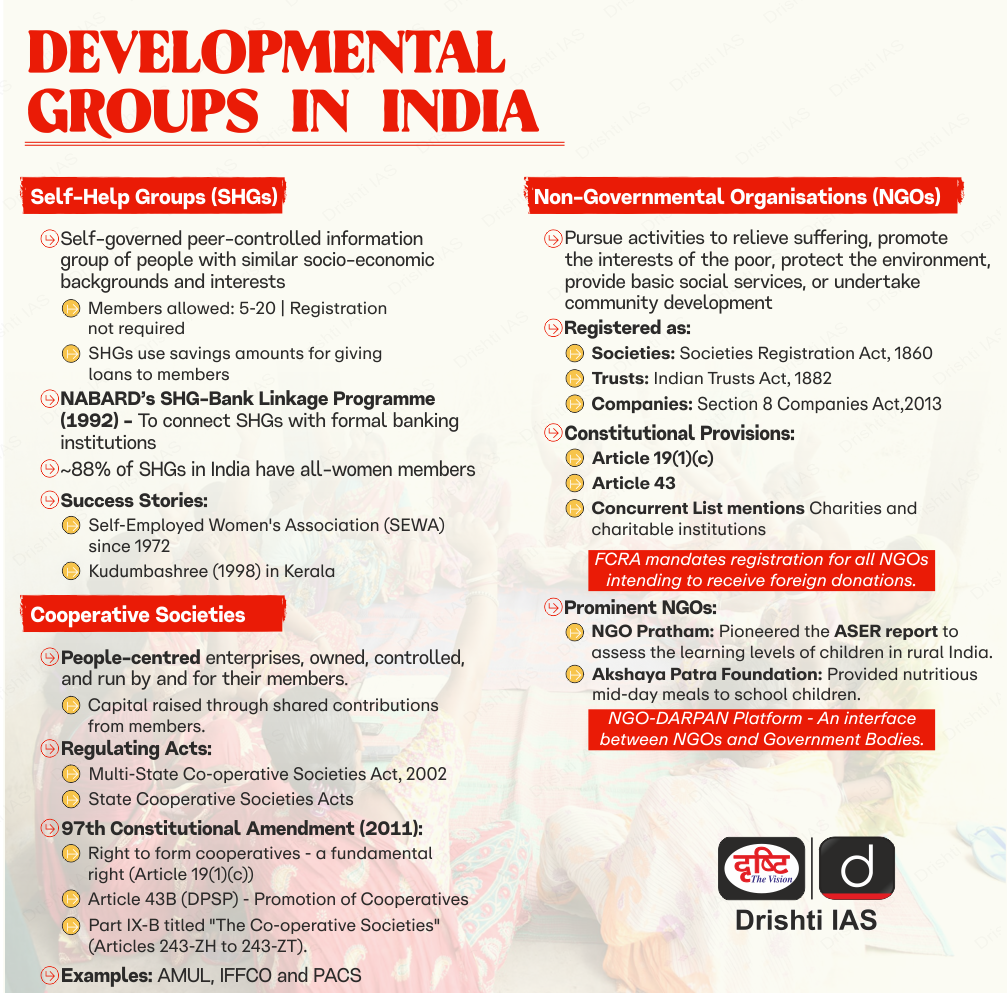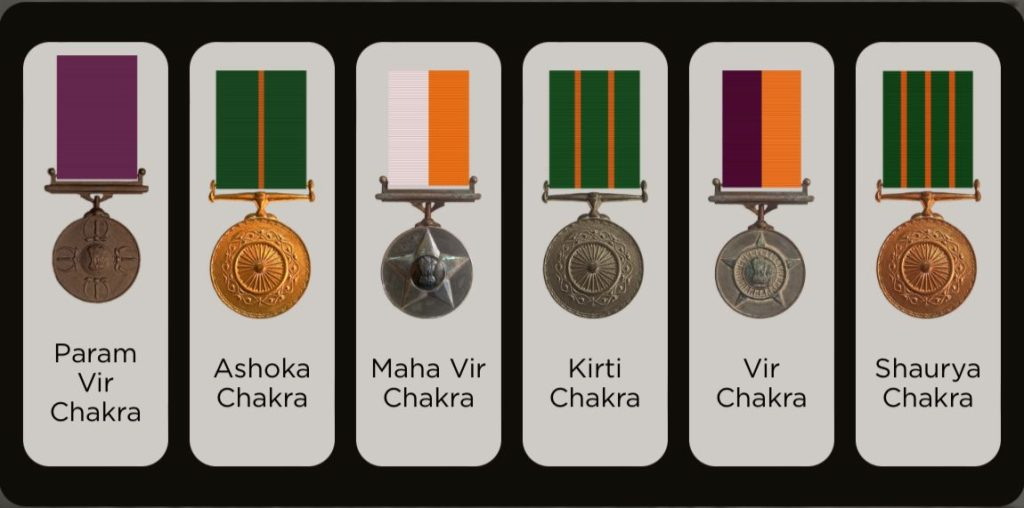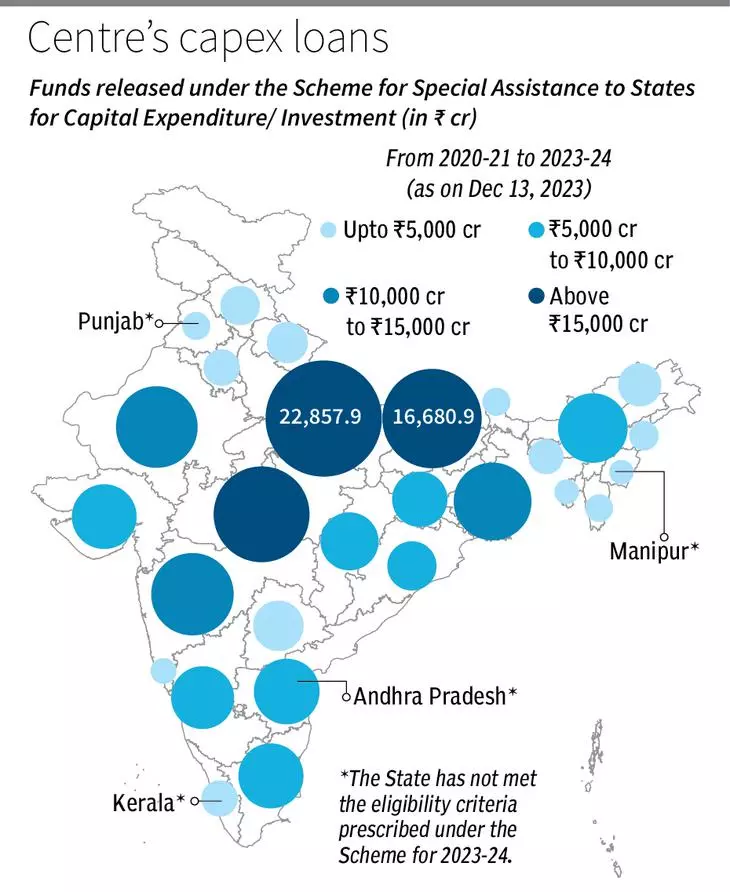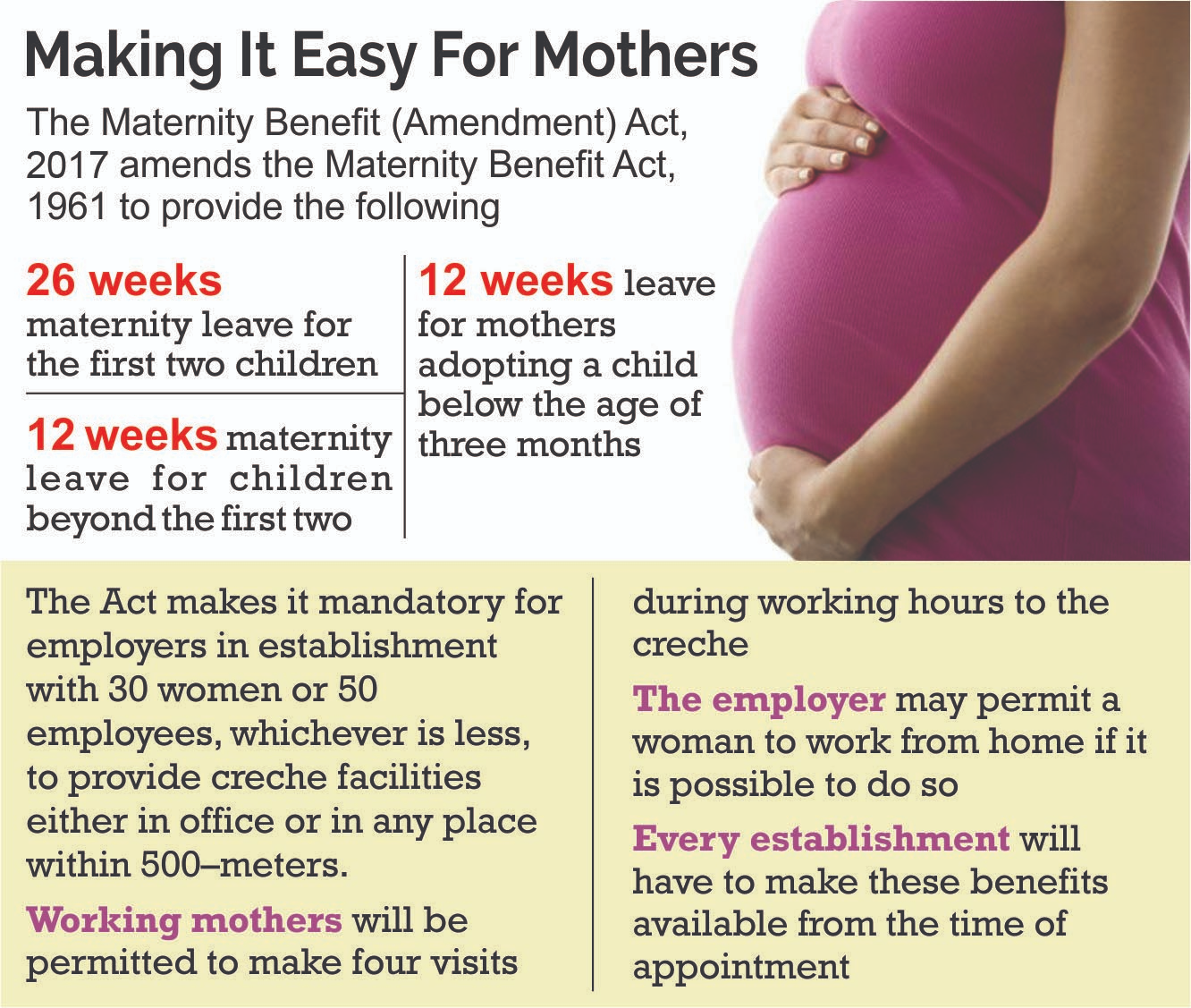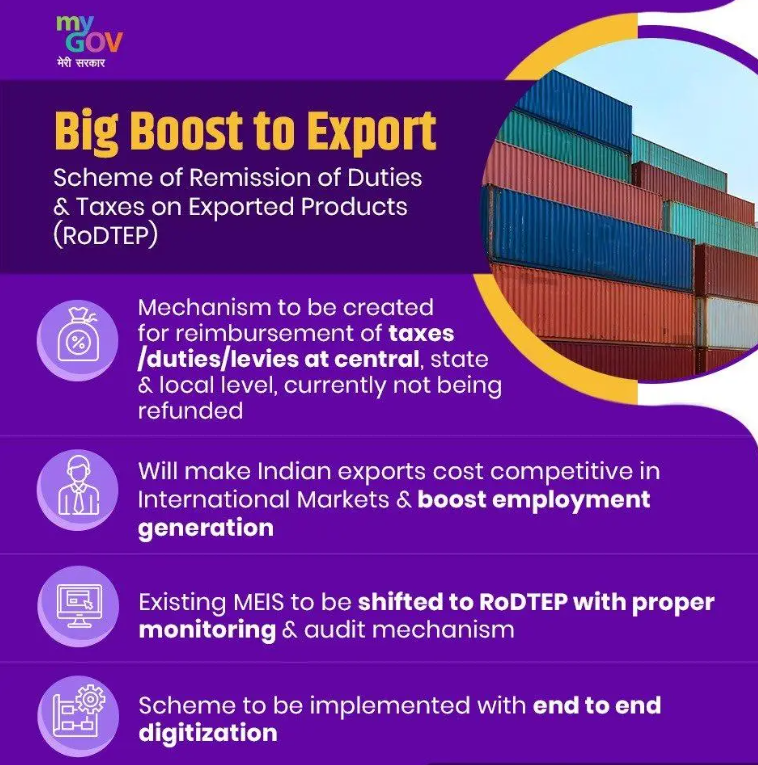Governance
Revisiting NGO Regulatory Framework
For Prelims: Foreign Contribution (Regulation) Act, Emergency, Association for Democratic Reforms (ADR), PM POSHAN, SEBI, World Wide Fund for Nature (WWF), Indian National Trust for Art and Cultural Heritage - INTACH.
For Mains: Regulation of NGOs under FCRA and suggested reforms for their better functioning in India.
Why in News?
The Ministry of Home Affairs (MHA) has recently announced new amendments to the Foreign Contribution (Regulation) Rules, 2011 affecting the manner in which non-governmental organizations (NGOs) operating in India can receive and utilize foreign funds.
What are the Key Provisions of the New FCRA Rules for NGOs?
- Ban on Publication Activities: If the association is engaged in publication-related activities, it should submit an undertaking from the chief functionary that it is not engaged in production or broadcast of news through electronic mode, and if registered with RNI, a 'not a newspaper' certification shall be submitted.
- Financial Disclosure: NGOs applying for FCRA, 2010 registration must submit financial statements and audit reports for the past three years, including assets and liabilities, income and expenditure, and receipts and payments accounts.
- FATF Compliance: NGOs must declare adherence to Financial Action Task Force (FATF) Good Practice Guidelines, aligning with India’s efforts to strengthen oversight of foreign financial flows.
- New Requirements for Receiving Foreign Contributions: NGOs must submit a commitment letter from foreign donors matching the donation with a detailed project report with expense breakdown.
- Obligations for Previously Registered NGOs: If an NGO’s FCRA registration has expired or been cancelled, it must submit an affidavit detailing the receipt and utilisation of previously received foreign contributions.
Foreign Contribution Regulation Act
- About: FCRA is a law enacted in 1976 during the Emergency to regulate the acceptance and use of foreign contributions by individuals, associations, and organizations in India.
- It ensures that such contributions are used only for legitimate purposes and do not compromise national interest.
- Amendments: The original FCRA Act, 1976 was repealed and replaced by new legislation in 2010 to modernise the law governing foreign contributions.
- In 2020, additional amendments were introduced to tighten the regulations and improve oversight of foreign donations.
What are NGOs and How are they Regulated in India?
- About: A NGO is a non-profit entity that functions independently of the government, focusing on humanitarian, social, or developmental objectives.
- Formation of NGOs in India:
- Societies: Registered under the Societies Registration Act, 1860.
- Trusts: Private Trusts are registered under the Indian Trusts Act, 1882 which is a central legislation.
- Public Trusts are registered under respective state laws.
- Charitable Companies: Registered as non-profit companies under Section 8 of the Companies Act, 2013.
- Foreign Contribution Regulation: NGOs that receive foreign contributions or donations must obtain prior registration or permission under the Foreign Contribution (Regulation) Act (FCRA), 2010, administered by the Ministry of Home Affairs (MHA).
- The FCRA, 2010 governs the receipt and utilization of foreign funds by individuals, associations, or companies, including NGOs.
- Its core objective is to prevent foreign contributions from undermining India’s sovereignty, integrity, security, economic or scientific interests, public order, or leading to any offence or harm to individuals.
- The FCRA, 2010 governs the receipt and utilization of foreign funds by individuals, associations, or companies, including NGOs.
- Key Amendments in the Foreign Contribution (Regulation) Amendment Act, 2020:
- Mandated that all foreign contributions be received only through a designated "FCRA Account" at a specified bank (State Bank of India, Delhi).
- Prohibited transfer of foreign contributions from the recipient to any other person or entity.
- Reduced the permissible limit for administrative expenses from 50% to 20% of the foreign funds received.
- Empowered the Central Government to:
- Restrict or suspend further receipt or utilization of foreign contributions following a summary inquiry.
- Require Aadhaar or other identification documents for office bearers, directors, and key functionaries of NGOs.
What are the Key Roles and Responsibilities of NGOs?
- Governance: NGOs strengthen democracy by promoting transparency and accountability, exemplified by the Association for Democratic Reforms (ADR) whose PILs led to mandatory disclosure of candidates’ criminal records, education, and assets.
- They also supplement government schemes like the Akshaya Patra Foundation, supporting the PM POSHAN initiative against malnutrition.
- Social Reforms: NGOs protect human rights (e.g., Bachpan Bachao Andolan), empower women (SEWA), represent marginalized groups like PLWHA (People living with HIV/AIDS) and LGBTQIA+ communities (Naz Foundation), and alleviate poverty (Goonj).
- Disaster Relief and Rehabilitation: NGOs like SEEDS India play a critical role in providing immediate aid and long-term rehabilitation support during natural disasters and emergencies.
- Environmental Conservation: Many NGOs like World Wide Fund for Nature (WWF) work to protect natural resources, promote sustainable development, and combat climate change through awareness campaigns and grassroots initiatives.
What are the Key Challenges Related to NGOs in India?
- Regulatory Restrictions: Strict FCRA regulations have resulted in the cancellation of NGO licenses, restricting access to foreign donations, while domestic CSR funds are largely directed toward corporate-linked NGOs, leaving smaller organizations underfunded and struggling.
- Trust Deficits: NGOs face accusations of "anti-national" activities, leading to audits, raids, and the closure of NGOs. E.g., Greenpeace India was banned for allegedly obstructing economic development through its campaigns against coal mining and nuclear power projects.
- Lack of Transparency: Some NGOs have been criticized for poor accountability and failure to comply with reporting requirements, leading to increased government scrutiny and a loss of public trust.
- In several instances, NGOs that did not file their annual returns faced cancellation of their FCRA registration.
What Key Reforms Are Needed to Strengthen NGO Regulation in India?
- Implement 2nd ARC Recommendations: FCRA implementation should be decentralized to ease bureaucratic hurdles, with balanced legislative interpretation that protects genuine NGOs from excessive regulation while preventing misuse of foreign funds.
- Stronger Anti-Money Laundering (AML) Checks: Link NGO funding regulations to FATF guidelines, as India is a member. Strengthen measures to block shell NGOs, similar to the 2017 crackdown on over 11,000 fake NGOs.
- Faster blacklisting of rogue NGOs can be achieved through automated alerts for fund diversion, similar to SEBI’s surveillance system.
- Encourage Domestic Funding: Provide tax incentives for Indian donors, and encourage Corporate Social Responsibility (CSR) partnerships with credible NGOs, such as Tata Trusts’ education initiatives.
Conclusion
The new FCRA amendments strengthen oversight of foreign-funded NGOs, ensuring transparency and national security. However, balanced reforms—like digital audits, Aadhaar-linked databases, and domestic funding incentives—are needed to prevent misuse while supporting genuine NGOs. Stricter FATF compliance and faster blacklisting of rogue entities will enhance accountability without stifling development work.
|
Drishti Mains Question: Examine the reforms needed for better regulation of NGOs receiving foreign funding in India. |
UPSC Civil Services Examination, Previous Year Question:
Mains
Q. Can Civil Society and Non-Governmental Organisations present an alternative model of public service delivery to benefit the common citizen? Discuss the challenges of this alternative model.


Facts for UPSC Mains
Inter-Services Organisations Rules 2025
Why in News?
India has notified the Inter-services Organisations (Command, Control and Discipline) Rules, 2025 under the Inter-Services Organisations (Command, Control and Discipline) Act, 2023.
- These rules aim to strengthen the command, control, and administrative efficiency of Inter-Services Organisations (ISOs), following the coordinated tri-service response during Operation Sindoor.
What are Inter-Services Organisations?
- About: ISOs are units or commands composed of personnel from two or more branches of the Armed Forces (Army, Navy, and Air Force). They are designed to facilitate integrated planning, operations, and logistics.
- Examples include tri-service commands like the Andaman and Nicobar Command or upcoming theatre commands under India's theaterisation plan.
- ISO Act 2023: The act addresses challenges arising from separate service laws, the Army Act (1950), Navy Act (1957), and Air Force Act (1950) which often hinder coordination and discipline in joint-service settings.
- While it does not amend these existing laws, the Act empowers ISO Commanders-in-Chief and Officers-in-Command with administrative and disciplinary authority over all personnel under their command, regardless of service.
- It formally recognises joint services command organisations like the Andaman and Nicobar Command and Defence Space Agency and allows the creation of new ISOs and Joint Services Commands and placed under the command of a Commander-in-Chief.
- The Centre retains overall control and sets eligibility for leadership roles, while Commanding Officers manage unit-level discipline and administration within ISOs.
- ISO Rules 2025: Notified under the Section 11 of the ISO Act, 2023. These rules aim to ensure efficient management of discipline and administration across the Army, Navy, and Air Force when operating under ISOs, such as joint commands or theatre commands.
- As per the 2025 rules, both the Joint Services Command and the Inter-Services Establishment comprise personnel from any two or all three armed forces.
- The Joint Services Command is headed by a Commander-in-Chief holding the rank of Lieutenant General, Air Marshal, or Vice Admiral.
- An Inter-Services Establishment is commanded by an Officer-in-Command with the rank of Major General, Air Vice Marshal, Rear Admiral, or higher.
- Under the ISO Rules 2025, if a Commander-in-Chief, Officer-in-Command, or Commanding Officer is on leave or absent, a replacement will be formally designated in the Inter-services unit’s orders.
- In emergencies without prior orders, the next higher formation will appoint a temporary substitute.
- Matters not covered by existing rules or Acts regarding command and control in Inter-services Organisations shall be referred to the Central Government for a decision.
- As per the 2025 rules, both the Joint Services Command and the Inter-Services Establishment comprise personnel from any two or all three armed forces.
What is the Significance of Inter-Services Organisations?
- Enhanced Operational Synergy: Integration under unified commands allows for joint planning and real-time coordination among Army, Navy, and Air Force units.
- The Kargil Review Committee (1999) highlighted the lack of coordination among the three armed services during the Kargil War and emphasized the urgent need for structural reforms. It recommended integrated commands to enhance joint operational effectiveness.
- This synergy is crucial to handle complex, multi-domain threats in the modern battlefield, particularly along the two-front scenario involving China and Pakistan.
- Optimal Use of Resources: ISOs enable pooling of logistics, maintenance, and support functions, preventing duplication and saving resources.
- The establishment of the first Tri-Service Common Defence Station in Mumbai (2024) reflects the move toward integrated infrastructure.
- Improved Combat Readiness: Joint training and planning enhance interoperability and preparedness for multi-domain operations including cyber and space warfare.
- Strategic Reform and Modernisation: Integration reflects a shift towards modern military doctrine and international best practices (e.g., U.S. and China).
- It aligns India’s military structure with evolving geopolitical challenges and encourages technological integration and doctrinal evolution to prepare for future warfare.
|
Drishti Mains Question: Discuss the significance of the Inter-Services Organisations in the context of India's military reforms. |
| Read more: India's Integrated Theatre Commands |
UPSC Civil Services Examination Previous Year Question (PYQ)
Prelims:
Q. In the Constitution of India, the promotion of international peace and security is included in the (2014)
(a) Preamble to the Constitution
(b) Directive Principles of State Policy
(c) Fundamental Duties
(d) Ninth Schedule
Ans: (b)
Mains
Q. Analyze the multidimensional challenges posed by external state and non-state actors, to the internal security of India. Also discuss measures required to be taken to combat these threats. (2021)
Q. “The diverse nature of India as a multi-religious and multi-ethnic society is not immune to the impact of radicalism which is seen in her neighborhood.” Discuss along with strategies to be adopted to counter this environment. (2014)


Important Facts For Prelims
Gallantry Awards 2025
Why in News?
The President of India conferred Gallantry Awards, including 6 Kirti Chakras (4 posthumously) and 33 Shaurya Chakras (7 posthumously), to personnel from the Armed Forces, Central Armed Police Forces, and State/UT Police that were announced on the eve of the 76th Republic day 2025.
What are the Gallantry Awards?
- About Gallantry awards: They are given to the personnel for displaying raw courage, unparalleled bravery and total disregard to personal safety in the line of duty.
- These gallantry awards are announced twice in a year, first on the occasion of the Republic Day and then on the occasion of the Independence Day.
- Types:
- Gallantry Award in the Face of Enemy:
- Param Vir Chakra (PVC): It shall have embossed on the obverse four replicas of "Indra's Vajra" with the State Emblem embossed in the centre.
- It is awarded for most conspicuous bravery or some daring or pre-eminent act of valour or self sacrifice, in the presence of the enemy.
- Param Vir Chakra (PVC): It shall have embossed on the obverse four replicas of "Indra's Vajra" with the State Emblem embossed in the centre.
- Mahavir Chakra (MVC): It shall have embossed on the obverse a five-pointed heraldic star with the points of the star just touching the rim. The star shall have in the centre a domed gilded State Emblem.
- It is awarded for acts of gallantry in the presence of the enemy.
- Vir Chakra: The star will feature a Chakra at its centre, with a domed centerpiece inside the Chakra bearing the gilded State Emblem.
- It is awarded for acts of gallantry in the presence of the enemy on land, at sea or in the air. The decoration may be awarded posthumously.
- Gallantry Award in the Face of Enemy:
- Gallantry Award Other than in the Face of Enemy:
- Medals: It includes Ashok Chakra, Kirti Chakra, and Shaurya Chakra, on which the obverse of the medal shall be embossed a replica of the respective chakra in the centre, surrounded by a lotus wreath.
- Along the rim, on the inner side, shall be a pattern of lotus leaves, flowers, and buds.
- On its reverse shall be embossed the respective words both in Hindi and English the two versions being separated by two lotus flowers.
- Medals: It includes Ashok Chakra, Kirti Chakra, and Shaurya Chakra, on which the obverse of the medal shall be embossed a replica of the respective chakra in the centre, surrounded by a lotus wreath.
- Order of precedence of the Award:
- Param Vir Chakra
- Ashoka Chakra
- Mahavir Chakra
- Kirti Chakra
- Vir Chakra
- Shaurya Chakra
- Eligibility:
- Param Vir Chakra, the Maha Vir Chakra and the Vir Chakra: All ranks of the Naval, Military, Air, Reserve, and Territorial Forces, including medical and nursing staff, and civilians serving under their direction.
- Ashoka Chakra, Kirti Chakra & Shaurya Chakra: All ranks of the Armed Forces, Reserve and Territorial Forces, Nursing Services, Police, Central Para-Military Forces, Railway Protection Force, and civilian citizens.
Note: For each subsequent act of similar bravery, recipients are recognized by a Bar to the Chakra.
- Also, both Chakra and Bar to the chakra for additional bravery may be awarded posthumously.
UPSC Civil Services Examination, Previous Year Question (PYQ)
Prelims
Q. Consider the following statements in respect of Bharat Ratna and Padma Awards: (2021)
- Bharat Ratna and Padma Awards are titles under the Article 18(1) of the Constitution of India.
- Padma Awards, which were instituted in the year 1954, were suspended only once.
- The number of Bharat Ratna Awards is restricted to a maximum of five in a particular year.
Which of the above statements are not correct?
(a) 1 and 2 only
(b) 2 and 3 only
(c) 1 and 3 only
(d) 1, 2 and 3
Ans: (d)
Q. Consider the following statements in respect of the Laureus World Sports Award which was instituted in the year 2000: (2021)
- American golfer Tiger Woods was the first winner of this award.
- The award was received mostly by ‘Formula One’ players so far.
- Roger Federer received this award the maximum number of times compared to others.
Which of the above statements are correct?
(a) 1 and 2 only
(b) 2 and 3 only
(c) 1 and 3 only
(d) 1, 2 and 3
Ans: (c)


Important Facts For Prelims
Scheme for Special Assistance to States for Capital Investment (SASCI)
Why in News?
The Centre’s 50-year interest-free capex loans under the Scheme for Special Assistance to States for Capital Investment (SASCI) are driving major land reforms across India by pushing states to modernise property systems, boosting efficiency, and industrial growth.
What is SASCI?
- About: The ‘Scheme for Special Assistance to States for Capital Expenditure’ was launched in 2020–21 in response to the Covid-19 pandemic.
- Later renamed as SASCI, it aims to stimulate economic recovery by providing interest-free assistance to states specifically for capital investment.
- Key Features:
- Capital Investment Focus: Provides long term interest free loans for a period of 50 years to states exclusively for capital expenditure projects.
- Capital expenditure boosts productive capacity, creates jobs, and drives sustainable growth. It has a high multiplier effect for every Rs 1 spent it is estimated to generate Rs 3 in Gross Domestic Product (GDP).
- Structure: Divided into multiple parts targeting different sectors, such as urban reforms, vehicle scrapping incentives, police housing, Make in India initiatives, digital infrastructure, Optical Fibre Cable, and tourism development.
- Capital Investment Focus: Provides long term interest free loans for a period of 50 years to states exclusively for capital expenditure projects.
- Progress:
- Massive Scale-Up: The scheme grew from Rs 12,000 crore in 2020-21 to Rs 1,50,000 crore in 2024-25, reflecting increased focus on capital investment.
- Widespread Industrial Reforms: Under SASCI 22 states updated building bylaws for industrial and commercial plots.
- Additionally, 18 states reduced land wastage by optimizing setbacks and parking norms, making more efficient use of available space.
- To support vertical industrial growth, 12 states have doubled the permissible built-up area for flatted factories.
- Furthermore, 8 states have raised the Floor Area Ratio (FAR) in commercial zones, thereby unlocking higher density development and boosting overall urban productivity.
- Rural Land Digitisation: Under SASCI 90% of cadastral maps (land ownership map) geo-referenced nationwide, and 30% of land parcels are assigned Unique Land Parcel Identification Numbers (ULPIN) (Bhu-Aadhar).
- Additionally, 91% of Records of Rights (legal documents containing all necessary information about a land parcel) digitised, enabling transparency and reducing disputes.
- Improved land administration and industrial reforms are expected to increase manufacturing capacity, streamline credit access, and enhance overall economic growth.
- Tourism: For the first time under SASCI, funds have been earmarked for tourism, with Rs 3,295 crore sanctioned for 40 projects across 23 states to develop iconic tourist centres at a global scale.
Capital Expenditure
- Capital Expenditure (Capex) refers to funds spent by the government or businesses on acquiring, upgrading, or maintaining physical assets such as infrastructure, machinery, or technology.
- Unlike Operating Expenses (Opex), which cover day-to-day operational costs, Capex involves substantial long-term investments recorded as assets and depreciated over time.
- The Indian government allocates Capex through its annual Union Budget, with Rs 11.21 lakh crore (3.1% of GDP) earmarked for FY 2025–26.
- Capex as a countercyclical fiscal tool, it stabilizes the economy during downturns and supports future revenue through asset creation.
- Capex also aids in reducing public liabilities via loan repayments and encourages private sector investment, making it essential for India’s sustained development and infrastructure expansion.
UPSC Civil Services Examination, Previous Year Question (PYQ)
Prelims
Q. Which of the following is/are included in the capital budget of the Government of India? (2016)
- Expenditure on acquisition of assets like roads, buildings, machinery, etc.
- Loans received from foreign governments
- Loans and advances granted to the States and Union Territories
Select the correct answer using the code given below:
(a) 1 only
(b) 2 and 3 only
(c) 1 and 3 only
(d) 1, 2 and 3
Ans: (d)


Rapid Fire
Death Anniversary of Pandit Jawaharlal Nehru
On 27th May 2025, the Prime Minister paid homage to India’s first Prime Minister, Pandit Jawaharlal Nehru—who died on 27th May 1964 and is remembered as the Architect of Modern India.
- About JL Nehru:
- Early Life: Born on 14th November 1889, in Prayagraj, he attended his first Congress session in 1912 at Bankipore (Patna) as a delegate and joined Annie Besant’s Home Rule League in 1916, becoming its Allahabad Secretary in 1919.

- Contribution in Freedom Struggle: He was elected Congress President at the 1929 Lahore session, passing the historic Purna Swaraj resolution for complete independence, and later presided over the 1936 Lucknow and 1937 Faizpur sessions, promoting socialism.
- He drafted Fundamental Rights and Economic Policy (1929-31), adopted at the 1931 Karachi Session under Sardar Patel, and advocated legal defence for Indian National Army (INA) soldiers.
- He led the Interim Government in 1946.
- Post-Independence: In 1953, he formed the States Reorganisation Commission, promoted industrialisation through Five-Year Plans, and led the Non-Alignment Movement.
- Awards: He was awarded the Bharat Ratna (1955) and World Peace Council Prize (posthumously, 1970).
- Literary Contributions: The Discovery of India, An Autobiography, Glimpses of World History and Letters from a Father to His Daughter.
- Early Life: Born on 14th November 1889, in Prayagraj, he attended his first Congress session in 1912 at Bankipore (Patna) as a delegate and joined Annie Besant’s Home Rule League in 1916, becoming its Allahabad Secretary in 1919.
| Read More: Jawaharlal Nehru |


Rapid Fire
Dholes
28th May is celebrated as World Dhole Day to promote the conservation of dholes—endangered Asian wild dogs—who play a crucial role as apex predators in maintaining forest ecosystem balance.
- About Dholes: Dholes (Cuon alpinus) are wild dogs native to southern and eastern Asia, including India’s Western Ghats (e.g., Valparai plateau).
- Characteristics: Dholes have auburn fur, black tails, amber eyes, and upright rounded ears, living socially in packs of 2 to 25.
- Habitat: Adaptable to forests, shrublands, and high mountain steppes.
- In India, dholes are found in three main areas i.e., the Western and Eastern Ghats, the central Indian landscape, and Northeast India.
- Diet and Hunting: Dholes are carnivores that hunt cooperatively in groups of 3-5, and communicate with yaps, growls, and distinctive whistles, earning them the nickname "whistling dogs."
- Dholes do not have the jaw strength to deliver a fatal bite to their prey, so the pack eats the prey alive.
- Reproduction: A pack usually has one dominant monogamous breeding pair, while the non-breeding members support by bringing food and caring for the pups.
- Conservation Status:
- IUCN: Endangered.
- CITES: Appendix II.
- Wildlife (Protection) Act, 1972: Schedule II.
| Read More: Dholes |


Rapid Fire
Maternity Benefits for Third Child
In the K. Umadevi v. Government of Tamil Nadu Case, 2022, the Supreme Court (SC) granted maternity benefits to a woman for her third child, under the Maternity Benefit (Amendment) Act, 2017 calling it a constitutional right.
- The SC affirmed that the right to health, dignity, privacy, and non-discrimination are integral to the Right to Life under Article 21 of the Constitution.
- It emphasized that reproductive rights form part of international human rights law, including rights to health, equality, and dignity.
- Right to reproductive choices is protected under Article 21 (Right to Life and Personal Liberty), as reaffirmed in the Suchita Srivastava v. Chandigarh Administration Case, 2009.
- Maternity Benefit (Amendment) Act, 2017: The Maternity Benefit Act, 1961, as amended in 2017, provides paid maternity leave and related benefits to women employees both before and after childbirth.
- Applicability: The Act applies to factories, mines, plantations, government establishments, shops, and other workplaces with 10 or more employees.
- Women covered under the Employees’ State Insurance Act, 1948 are also entitled to maternity benefits.
- Maternity Leave: Women are entitled to 26 weeks of paid maternity leave for up to two children, and 12 weeks for with more than two i.e., the Act does not prohibit maternity leave for women with more than two children; it only limits the duration based on the number of children.
- Applicability: The Act applies to factories, mines, plantations, government establishments, shops, and other workplaces with 10 or more employees.
| Read More: The Maternity Benefit (Amendment) Act 2017 |


Rapid Fire
RoDTEP Scheme
India has reinstated the Remission of Duties and Taxes on Exported Products (RoDTEP) scheme benefits for exports by Advance Authorization (AA) holders, Export-Oriented Units (EOUs), and Special Economic Zone (SEZ) units.
- RoDTEP benefits for these categories, halted in February 2025, have now been reinstated to ensure a level playing field for all exporters.
- The restoration, effective from June 2025, aims to boost export competitiveness and enhance global market access.
- RoDTEP Scheme: Launched in 2021 by the Ministry of Commerce and Industry, the RoDTEP scheme is designed to reimburse exporters for embedded duties, taxes, and levies that are not otherwise refunded under any other existing scheme.
- The RoDTEP scheme, which replaced the Merchandise Export from India Scheme (MEIS), is fully aligned with World Trade Organization norms.
- Rebates under RoDTEP Scheme will be issued as transferable duty credits or electronic scrips (e-scrips), maintained in an electronic ledger by the Central Board of Indirect Taxes and Customs (CBIC).
- As of March 2025, total disbursements under the RoDTEP scheme exceeded Rs 57,976 crore, highlighting its critical support for India's exports.
| Read more: RoDTEP Scheme |



